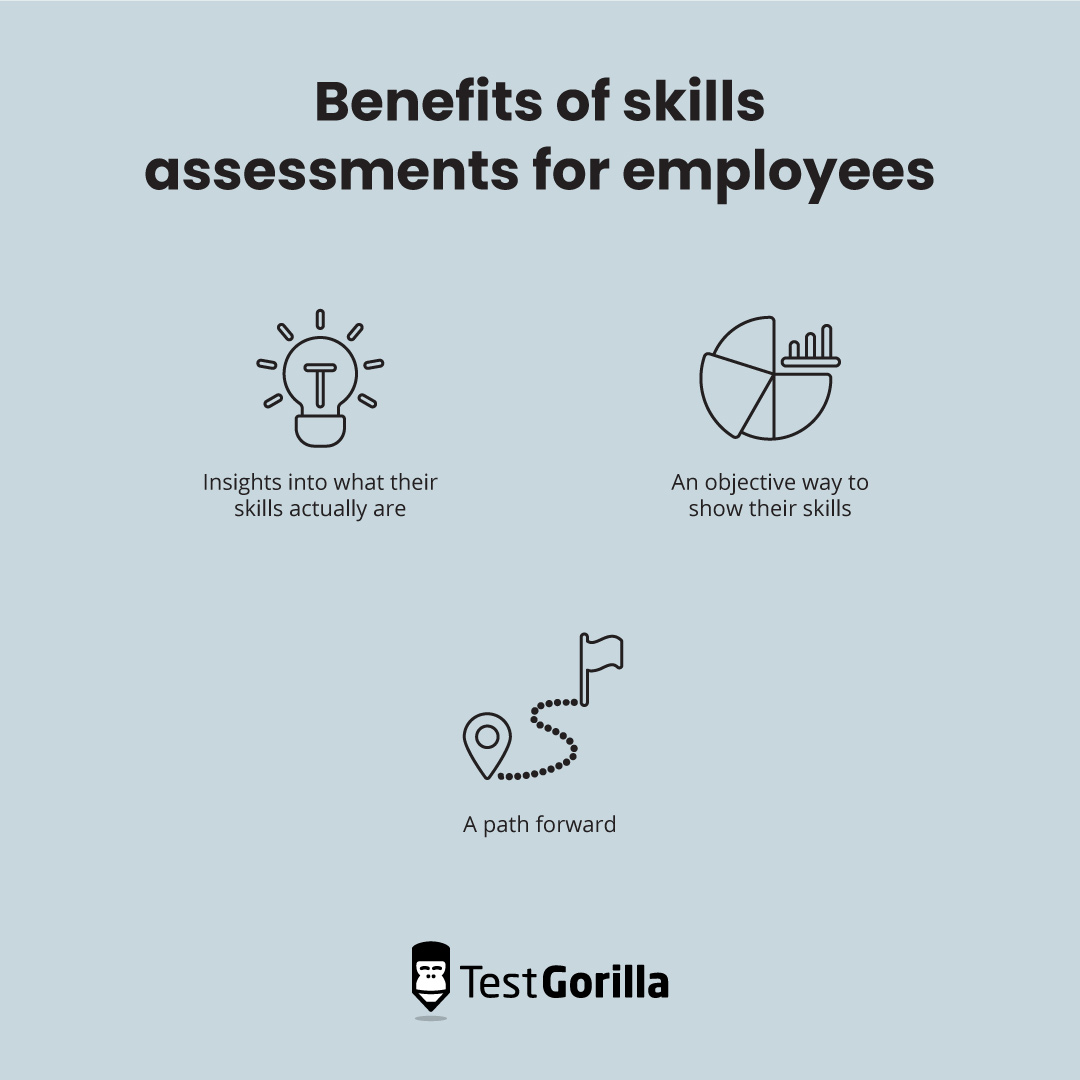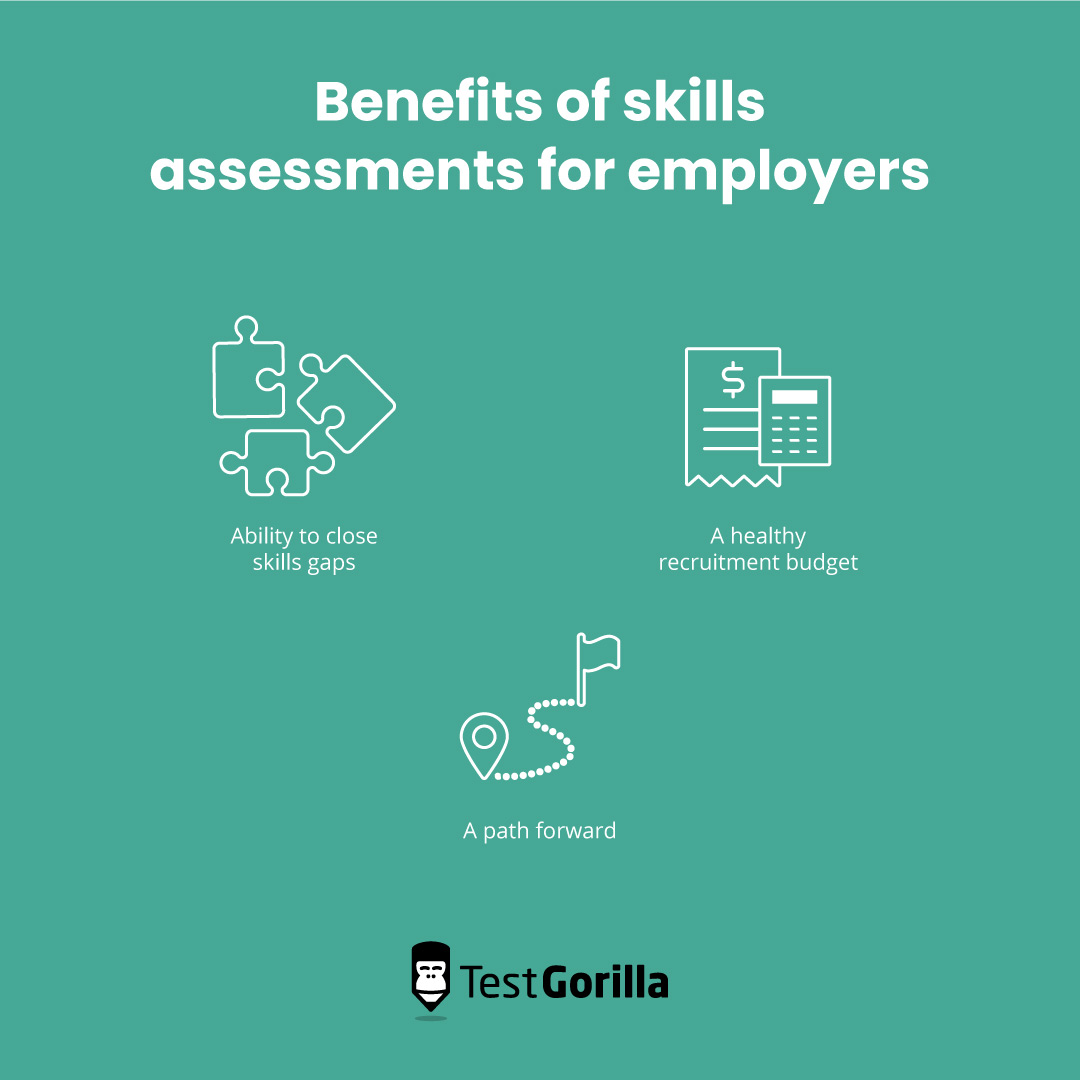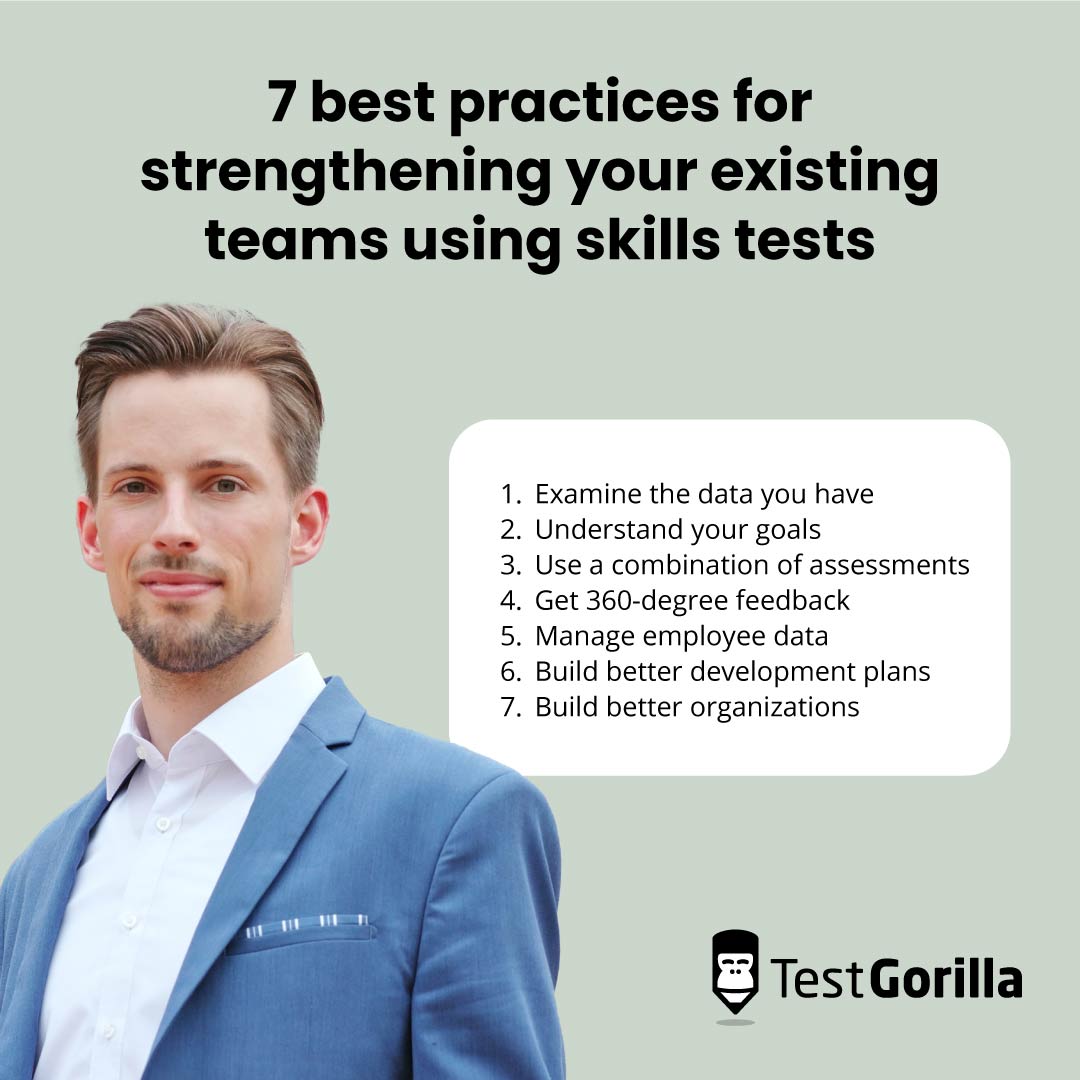Your ability to attract and retain talent is crucial to your organizational success. But what about the talent you already have?
Research shows that most organizations don’t know the skills and capabilities present within their workforces, and only 30% of organizations feel they have the skills to succeed in the future.[1]
Without a detailed understanding of team skills, employers lack the proper insight to know which employees can succeed in a given role. They also cannot offer employees the right training and development opportunities, leading to decreased productivity and low team morale.
Using tests for your existing team is a skills-based initiative that keeps employers up to speed on team skills, and identifies ways to nurture and develop existing talent.
In this guide, we examine how employee skills assessments:
Give you a snapshot of individual and team skills
Identify skills gaps
Build better development plans
Build better teams and organizations
Table of contents
What are skills tests?
Skills tests are assessments that are typically used by hiring managers to determine if a candidate can perform well in a role.
These assessments evaluate a candidate’s hard and soft skills, personality, character, and judgment, and give recruiters a competitive advantage in the job market.
Skills test | Evaluation |
Cognitive ability | Assesses an individual’s critical thinking and problem solving skills – with the
, for example |
Language | Measures an individual’s proficiency in the language(s) relevant to the position |
Personality and culture | Measures how a candidate or employee’s values and behaviors align with your organization, like with the
|
Programming | Analyzes skills like coding ability and understanding of algorithms |
Role-specific | Evaluates candidates on foundations and principles of a particular job |
Situational judgment | Examines how candidates would perform in a particular job-related situation |
Software skills | Tests proficiency with certain software platforms |
What are the benefits of skills tests?
Skills tests benefit employers by locating skilled candidates and providing valuable data about existing employee skills.
They also benefit the employee by involving them in their own development and making them aware of what their strengths and weaknesses are in a given role.
These skills assessments give employees:
Insights into what their skills actually are
: An individual may not realize how much they have already developed or how much they need to improve
An objective way to show their skills:
Skills tests
to give every candidate a fair shot to show their abilities
A path forward:
If they learn they have X skills, they know what they need to learn to get Y skills
And, they give employers:
Ability to close skills gaps
: Skills assessments are a crucial part of your
. They identify where employees need to improve or can be upskilled to fill positions and measure their success.
A healthy recruitment budget:
Upskilling promotes employee growth, and reskilling lets staff transfer their skills to other roles, both of which increase retention and lower hiring costs.
A path forward:
With accurate testing data, employers improve their development plans, decide to part ways with an employee, or adjust their reskilling/upskilling strategies.
Skills tests do more than just assess your teams’ skills. They help you keep and develop talent for the long term.
7 best practices for strengthening your existing teams using skills tests
It’s not enough, however, to simply distribute skills tests and call it a day. There are a few best practices we recommend for maximizing your utilization of skills tests.
Implementing assessments without an understanding of goals, testing data, or protections against bias can actually weaken teams.
For example, most organizations rely on performance reviews where employees write about their accomplishments and what they need to work on. Managers take that information and offer their own opinions on where staff succeeded or fell short.
Most of these performance evaluations are biased because they do not implement the multi-measure testing that skills-based hiring practices offer. They’re also intentionally open-ended to accommodate all levels and roles within an organization.
Multi-measure testing eliminates this ambiguity and establishes criteria on which to evaluate everyone fairly.
If you want to gain actual value from testing your existing team, use these steps as a guide:
Best practices
| Benefits
|
Examine the data you have | Get an overview of existing skills to improve workplace communication and build development plans |
Understand your goals | Identify where your team can improve to grow your business and increase employee engagement |
Use a combination of assessments | Fairly represent employees’ existing skills and eliminate bias |
Get 360-degree feedback | Use self-assessments to make employees active participants in their development |
Manage employee data | Analyze test results to boost individual and team performance |
Create better development plans | Use testing data to strengthen employee skills, identify career progression, and cultivate leadership potential |
Build better organizations | Create effective training programs and understand how team members complement each other |
1. Examine the data you have
Using tests for your existing teams does not mean you have to start from scratch. Chances are you already have access to data that can answer questions like:
What are your employee’s current skills?
Where do they fall short?
What do they express interest in?
What tasks or situations do they avoid?
A great way to gather data to answer these questions is to go to the source. Ask your workers what they think their skills are. What are they experts in? Where could they use improvement?
Taking this first step also improves your workplace communication and enables you to better understand worker needs and preferences, in addition to skills.
They may have all the skills in the world, but if employees don’t feel seen or heard, those skills may not be coming through.
Some other places you can find valuable employee data are:
LinkedIn profiles: Learn about what skills they claim to have versus what is being performed to get a sense of what their own performance expectations are
Resumes: If you screened for resumes when they were hired, reference their listed experience and skills to draw comparisons to performance
These two resources show employers where their staff might fall short of their listed skills, but they also reveal untapped abilities that their current roles do not require or that have been overlooked.
Existing employee work should also be used to create skills profiles and conduct a skills-gap analysis to:
Adapt your training efforts to employees’ unique needs
Distribute learning and development resources more efficiently
See where employee skills fall short of responsibilities
Identify existing skills to establish a plan to boost productivity
You can ask managers or team leaders to provide feedback on work quality for employee target groups. But remember: Avoid general questions about worker performance in favor of more strategic ones.
For example, rather than ask your manager, “Is there good communication within your team?” ask them, “How often does employee X communicate their project needs to you?”
This data sets the stage for building better development plans and a stronger organization.
2. Understand your goals
Testing your team is ineffective if you don’t have a clear picture of what your goals are.
Ask yourself these questions:
What are you going to do with this skills data?
What problems are you trying to solve?
What are your business objectives?
What skills can meet those objectives?
Some of these answers come from your skills-gap analysis, but it is also important to understand the different types of goals you may be setting.
Personal development goals can be related to developing new technical skills, like coding or programming, for example. But personal development doesn’t end there. Your goal can be to create a growth mindset for your staff or improve productivity, learning, reading, and leadership.
The SMART goal-setting framework is a helpful tool to use when establishing your goals and understanding their value:
What your goal should be | Why it’s important |
Specific | Having a clear-cut goal makes it easier for your employee to understand exactly what they need to do to accomplish it. |
Measurable | If you can’t measure your goal, then your staff won’t know if they’ve reached it. Becoming a better presenter isn’t a measurable goal, but leading ten presentations is. |
Achievable | Reaching your goal should be doable, and within a realistic timeframe. Consider what skills your candidate has or needs to achieve the goal. |
Relevant | The goal needs to be relevant for the worker to want to achieve it. |
Time-bound | Working towards a goal needs to happen on a clear timeline to maintain urgency and employee engagement. |
It’s important to note that understanding your goals should never come at the expense of respecting your employees’ time and feelings throughout the process.
Remember, you are using skills tests to identify areas where your organization can improve and grow, not to people out.
Don’t make the mistake that this employer did:
SourceMisusing employee assessments like this is not only hurtful, it negatively impacts engagement and morale. Employee engagement, not to be confused with job satisfaction, is an employee’s emotional commitment to an organization and its goals. According to a Gallup study, teams with low employee engagement experience turnover rates that are 18% to 43% higher than teams with higher engagement. Filling skills gaps and achieving business goals should never threaten the safety and autonomy of your existing workers. Assessments should entice people to grow with your organization, not run away from it.
3. Use a combination of assessments
Employers should never rely on a single test to determine who to hire or how an individual is performing. This can lead to bias and the improper use of a particular test. For example, if you are using a technical skills test but are more interested in your employee’s personality type, their test results may appear irrelevant or devoid of character. That’s why it’s crucial to understand your tests. Understanding how each test functions and what it is assessing keeps your process free of bias and delivers accurate results about your team. A skills-based hiring approach uses a combination of multi-measure assessments to get the most accurate read of employee performance and development. Let’s say you are the employer of a talent agency, for example. You notice that your talent agents do not show all of the same skills when it comes to addressing the following responsibilities:
Finding work for their clients
Negotiating contracts on behalf of their clients
Career management
Providing support and representation
Networking
Marketing and promotion
Some agents are able to attract more clients than others. Some agents are able to close bigger deals faster. A sales test can tell you a lot about performance, but each of these responsibilities can be tested in multiple ways. That’s where a combination of tests comes in handy. Negotiating contracts, for example, requires a blend of hard and soft skills. Using a Negotiation test evaluates a person’s ability to:
Control and drive discussions regarding their clients
Pitch projects to talent
Leverage the psychology of the counterparty
Influence casting departments, commercial partners, and other potential collaborators
Use emotional intelligence to negotiate effectively
Always strive to get a detailed view of your staff’s skills and performance so they are being fairly represented and sufficiently supported in the workplace.
4. Get 360-degree feedback
A big part of that detailed view is getting feedback from your people. Employee feedback can be easily incorporated into their self-assessments. These assessments invite team members to rate their established goals, competencies, and overall performance, and make them active participants in their own development.[2] Self-assessments also increase workers’ commitment to:
Goal setting
Competency development
Career planning
If you want reliable 360-degree feedback, make sure to remind your workers that not every assessment is a test with a right or wrong answer. Giving your team this information has two benefits:
It encourages them to communicate honestly about their workplace experiences.
If they struggle with being open, it gives insights into their personality. If an employee prefers to take tests with clearly defined answers, they may perform better in different areas of your organization.
Personality tests, for example, give employers insight into how people behave and respond emotionally to different topics or situations. There is no right or wrong way to experience an emotion. Sure, there are certain behaviors that do and do not belong in the workplace. But personality tests should be used in tandem with other multi-measure assessments to get to know your employees better. If they are used as the sole indicator of an individual’s success, they lead to increased bias and give you an inaccurate read of your workforce. In addition to a self-evaluation, you can ask for feedback from:
Peers
Managers
Mid- and entry-level employees
A few things to keep in mind when asking for feedback:
Feedback is subjective:
Keep in mind the unique context for each employee and monitor trends to get an overall picture.
Feedback will look different:
The relationship between an employee and a manager might be completely different on a creative team vs. a legal team, for example. The former may have a more casual communication style whereas the former may be a more hierarchical relationship where employee feedback may be perceived as insubordination.
Employees may be uncomfortable:
Staff
giving their employers, managers, or peers constructive feedback. That’s why feedback should always be geared toward a team member’s development and flourishing. It should never be a directive or an ultimatum.
You can also learn how to create your own tests to assess your employees’ hard skills when it comes to drawing up and reviewing talent contracts, for example.
5. Manage employee data
Now that you have gathered employee data through assessments and 360-degree feedback, it’s important to understand how you’ll use this information. Are you using tests to gather data and develop workers on an individual level or team level?Developing individual employee performance helps employers understand what an individual values and wants. According to Gallup, employees want these three things the most from their employer:
Increases in income or benefits (64%)
Greater work-life balance (61%)
The ability to use their strengths (58%)
The data you gather from skills tests, personality assessments, and 360-feedback assessments helps you understand what motivates individuals, and how to make them feel supported. An individual employee may:
Have goals that diverge from the team’s goals
Be unaware of how to utilize their skills to benefit the team
Serve the team’s goals at the expense of their own development.
For example, a UX designer may withhold their innovative ideas because they want everyone else to have a say on how to design an app. They believe they are helping the team by keeping their valuable ideas to themself when in reality their skills and development would help the team even more.Or, let’s say the same person is more productive in a research role but didn’t know until they took an aptitude test that assessed their transferable research skills. The data that you collect from your skills tests and multi-measure assessments should inform how you develop not only individual workers, but also the larger employee ecosystem. Developing team performance involves collecting and managing employee data to:
Ensure teams have the right skill sets to succeed and grow the business
Ensure teams have the necessary resources
Establish benchmarks for what an effective team looks like
With this skills-based approach, you have a scientific method for tracking your team’s learning and development from pre-hire to the present.
6. Create better development plans
Testing your teams’ skills gives you insight into how to build better professional development plans.But what is a professional development plan, exactly? A professional development plan is usually a document that establishes a worker’s career goals and provides details for how they can meet them. These plans contain:
Employee strengths
Areas of improvement
Resources they need
Strategies to implement
Professional development plans have significant benefits for employers and employees alike. An upside for employers is that they increase employee retention. According to a 2019 LinkedIn study, 94% of employees said they would remain at their workplace if it invested in their learning and development.[3]Increasing employee retention saves time and money on recruiting costs, increases job satisfaction, and minimizes productivity losses from mis-hires and turnover. For employees, professional development plans:
Learn new skills
Advance their careers
Discover new opportunities
Develop their goal-setting skills
The benefits to each group are not mutually exclusive. A stronger employee means a stronger organization. Multi-measure assessments like technical skills tests, personality tests, situational judgment assessments, aptitude tests, and self-assessments all come into play when creating professional development plans. They also identify a person’s career progression and leadership potential: becoming a manager vs. becoming an individual contributor (also known as a subject matter expert), for example. If the goal of using tests for your existing team is to address a skills gap in your management pool, professional development plans build a leadership path toward that role.
7. Build better organizations
Skills tests help upskill or reskill an individual employee for their own professional development, but they also build better teams on the whole. For example, an organization gives skills assessments to a specific department and then analyzes the results. The data they obtain from the assessments is used to create a training program for employees to address skills gaps and communication breakdowns, and increase learning, development, and collaboration. Once the staff completes the training, they’re tested again to measure improvement. Testing for skills is a great way to figure out where improvements need to be made, whether new hires are needed, or whether a development initiative is making an impact. But they also build high-performing teams by:
Centering skills in the hiring and development processes
Reducing bias in hiring and post-hiring assessments
Boosting diversity and innovation
Setting clear goals
Encouraging open and honest communication
All of these factors combined help you see your team as more than a group of talented individuals. Skills-based organizations use testing data to unlock employee potential and determine which skills complement each other. Testing your team does more than point out high-performers. It shows your team members how to support each other to achieve great results for your business.
Use skills tests to develop careers and grow your organization
Skills tests are central to skills-based hiring strategies that increase talent retention, eliminate bias, and save time and money in the recruitment process. But these tests are also essential to developing individual employees and building strong, productive organizations. Multi-measure assessments, personality tests, aptitude tests, cognitive ability tests, and technical skills tests, must all be catered to your specific organization’s needs to be the most effective. Goals must be set, communication must be present at all stages, and employee experience should be a priority. Skills tests play a role in growing employees’ careers, which has a positive impact on job satisfaction.Learn more about what really matters to employees with our job satisfaction guide.
Sources
“Accelerating Total Workforce Readiness”. (September 30, 2021). I4cp.com. Retrieved April 27. 2023. https://www.i4cp.com/press-releases/study-only-30-of-companies-say-their-employees-have-needed-skills-but-few-understand-current-capabilities
“Performance Management and Resources Guide: Managing Performance for Success”. (August 16, 2018). University of Virginia. Retrieved April 27, 2023. https://hr.virginia.edu/sites/default/files/PDFs/Conducting_a_Self_Evaluation.pdf
Chelovechkov, Artem, et. al. (2019). “3rd Annual 2019 Workplace Learning Report”. LinkedIn Learning. Retrieved April 27, 2023. https://learning.linkedin.com/content/dam/me/business/en-us/amp/learning-solutions/images/workplace-learning-report-2019/pdf/workplace-learning-report-2019.pdf
Related posts
Hire the best candidates with TestGorilla
Create pre-employment assessments in minutes to screen candidates, save time, and hire the best talent.
Latest posts
The best advice in pre-employment testing, in your inbox.
No spam. Unsubscribe at any time.

Hire the best. No bias. No stress.
Our screening tests identify the best candidates and make your hiring decisions faster, easier, and bias-free.
Free resources
This checklist covers key features you should look for when choosing a skills testing platform
This resource will help you develop an onboarding checklist for new hires.
How to assess your candidates' attention to detail.
Learn how to get human resources certified through HRCI or SHRM.
Learn how you can improve the level of talent at your company.
Learn how CapitalT reduced hiring bias with online skills assessments.
Learn how to make the resume process more efficient and more effective.
Improve your hiring strategy with these 7 critical recruitment metrics.
Learn how Sukhi decreased time spent reviewing resumes by 83%!
Hire more efficiently with these hacks that 99% of recruiters aren't using.
Make a business case for diversity and inclusion initiatives with this data.























